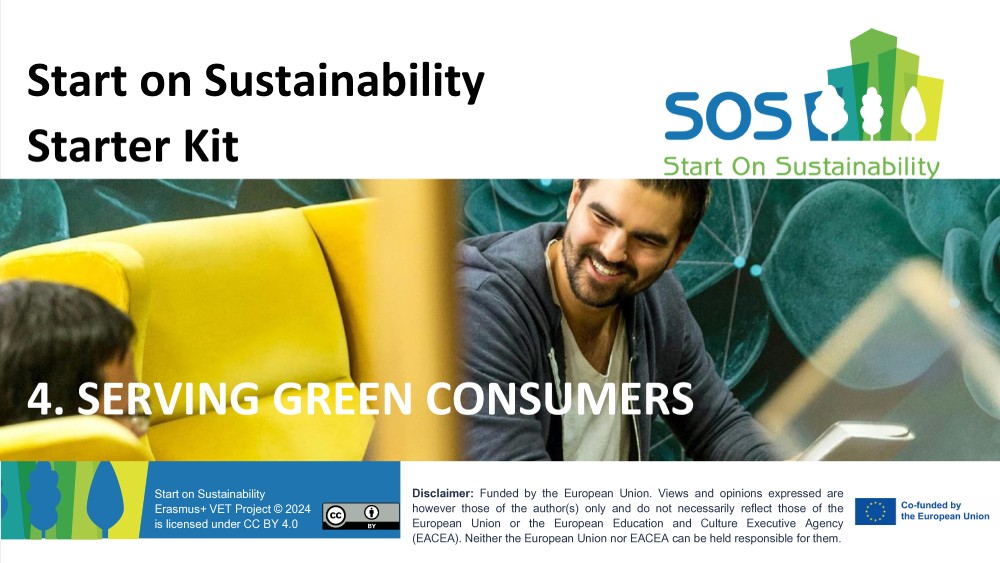
Unit 4 helps teams understand green consumers and how to serve them well. It covers green consumption, green products, green marketing, and the practical steps that turn customer intent into real choices.
What this unit covers
- Green consumption: what it is and how purchase, use, and disposal choices affect the environment.
- Green products: features that reduce harm across the product life cycle.
- Green consumerism: how awareness, values, and social norms shape buying behaviour.
- Green marketing: honest, evidence-based marketing that supports better choices.
- Targeting and serving green customers: removing barriers, building trust, and making sustainable options easy to pick.
Learning outcomes
By the end of Unit 4, learners will be able to:
- Explain the difference between green consumption, green products, and green marketing.
- Identify the barriers that stop customers from acting on their intentions.
- Design product, pricing, placement, and promotion choices that close the “say–do” gap.
- Communicate sustainability clearly and credibly without greenwashing.
- Use simple KPIs to track uptake and impact.
Key ideas in plain terms
1) Green consumption
Customers consider the footprint of buying, using, and disposing. They prefer durable goods, recyclable materials, and lower energy use. They avoid excess packaging and toxic inputs.
2) Green products
Look for features that cut resource use and pollution: recyclable or recycled materials, efficient operation, reduced packaging, fewer hazardous substances, and a lower-impact life cycle.
3) Green consumerism
Awareness is rising, but behaviour is mixed. People want greener options, yet price, convenience, and performance still decide many purchases. Support matters: standards, clear labels, and simple guidance help.
4) Green marketing (done right)
Green marketing is not slogans. It is better products, transparent claims, plain language, and proof. It educates customers and helps them choose well.
What shapes green buying?
- Performance and value: the product must work at least as well as the standard option.
- Price and total cost: clear value for money; highlight savings (energy, maintenance).
- Access and visibility: stock availability and clear placement online/in-store.
- Proof and trust: eco-labels, certifications, and concise evidence customers can verify.
- Attitudes and norms: culture, age, income, and environmental concern all play a role.
- Education: short, practical guidance helps people act, not just intend.
Step-by-step: serving green customers
- Know your customer segments
Identify who is most likely to buy green in your market. Note their barriers (price, performance, information, habit). - Build a better (not just greener) product
Match or beat standard alternatives on performance and reliability. Make durability and repairability visible. - Make the choice easy
- Clear labels and comparison tables.
- Default to greener options where fair (e.g., delivery, packaging).
- Offer “good–better–best” tiers.
- Price and value
Use fair pricing, bundles, or savings guarantees. Show lifetime cost (e.g., energy saved in 2 years). - Be transparent
Share the top 3 impact claims, how you measured them, and what you will improve next. Avoid vague terms. - Educate and nudge
Short guides, in-cart prompts, and post-purchase tips (use, care, disposal). Reward returns and refills. - Measure and improve
Track uptake, returns, satisfaction, and environmental impact. Tweak offers and messages based on results.
Practical activities you can use tomorrow
- Shelf/website audit: is the greener option easy to find and compare? Fix wording, filters, and placement.
- Claim sanity check: rewrite every environmental claim in one sentence a 12-year-old can understand, with a source.
- Say–do gap review: pick one product and list the three biggest barriers; design one fix per barrier.
- Post-use plan: create simple instructions for repair, refill, or recycling and include them with every sale.
Green marketing: do’s and don’ts
Do
- Lead with performance, then show the environmental benefit.
- Use recognised labels and make data findable.
- Tell a short improvement story: what’s better now, what’s next.
Don’t
- Overclaim or use vague language (“eco-friendly”, “green”) without proof.
- Hide trade-offs or bury key details.
- Offer a “green” product that is hard to buy, use, or dispose of responsibly.
Case snapshots (simple patterns)
- Packaging SME: switches to lighter, recyclable materials; adds a disposal QR code; uptake rises as customers see cost and waste savings.
- Retailer: defaults to low-impact delivery and right-sized packaging; customers can opt out; waste and costs fall.
- Food brand: clear sourcing map and recipe tips to cut home waste; loyalty improves alongside repeat purchase.
Measures that matter
- Uptake: % of green products in total sales; repeat purchase rate.
- Customer effort: clicks to find green option; time to decide.
- Trust: claim comprehension score; complaints about green claims.
- Impact: packaging reduced per order; energy/water saved per unit; items repaired/refilled.
- Return & end-of-life: % returned for refill/repair/recycling.
Assessment (sample questions)
- What distinguishes green consumption from green marketing?
- Name two barriers that stop customers from buying green.
- Give two ways to make sustainable choices easier at the point of sale.
- What evidence should support an environmental claim?
(An answer key can be added to match your context.)
Key terms at a glance
Green consumption, green product, green consumerism, green marketing, eco-label, life-cycle impact, say–do gap, durability, repairability, circularity.
Shared definitions help teams and learners stay aligned.
How to use Unit 4 in your business or classroom
- 90-minute workshop: map segments, barriers, and one “make it easy” fix.
- Copy clinic: rewrite top 5 product claims with clear evidence.
- Pilot: default the greener option for one product line for 60 days; track results.
- Review: monthly metrics, customer feedback, and next improvements.



